新人教版高二英语必修五
- 格式:pptx
- 大小:353.86 KB
- 文档页数:32
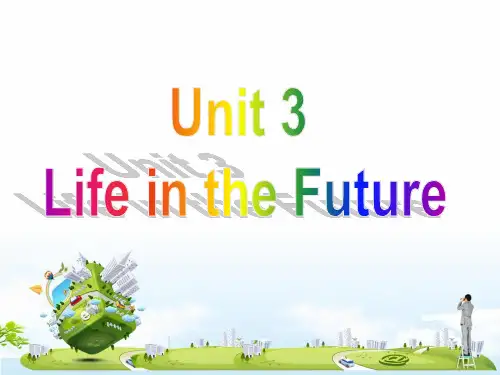
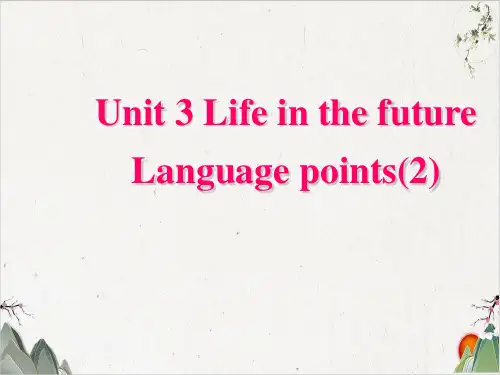
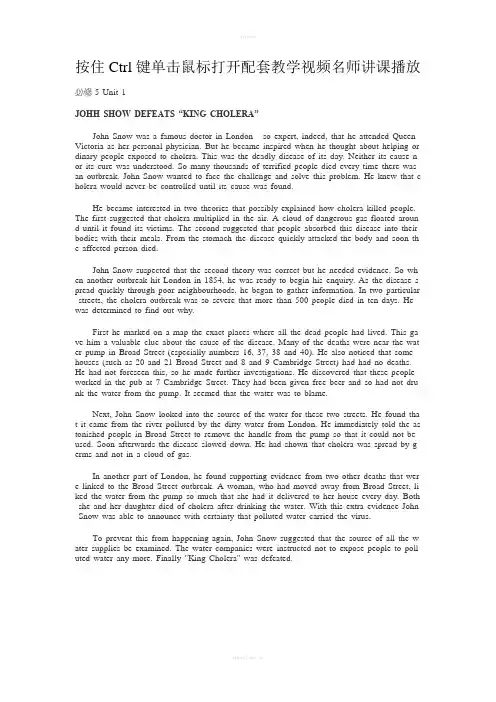
按住Ctrl键单击鼠标打开配套教学视频名师讲课播放必修5 Unit 1JOHH SHOW DEFEATS “KING CHOLERA”John Snow was a famous doctor in London - so expert, indeed, that he attended Queen Victoria as her personal physician. But he became inspired when he thought about helping or dinary people exposed to cholera. This was the deadly disease of its day. Neither its cause n or its cure was understood. So many thousands of terrified people died every time there was an outbreak. John Snow wanted to face the challenge and solve this problem. He knew that c holera would never be controlled until its cause was found.He became interested in two theories that possibly explained how cholera killed people. The first suggested that cholera multiplied in the air. A cloud of dangerous gas floated aroun d until it found its victims. The second suggested that people absorbed this disease into their bodies with their meals. From the stomach the disease quickly attacked the body and soon th e affected person died.John Snow suspected that the second theory was correct but he needed evidence. So wh en another outbreak hit London in 1854, he was ready to begin his enquiry. As the disease s pread quickly through poor neighbourhoods, he began to gather information. In two particular streets, the cholera outbreak was so severe that more than 500 people died in ten days. He was determined to find out why.First he marked on a map the exact places where all the dead people had lived. This ga ve him a valuable clue about the cause of the disease. Many of the deaths were near the wat er pump in Broad Street (especially numbers 16, 37, 38 and 40). He also noticed that some houses (such as 20 and 21 Broad Street and 8 and 9 Cambridge Street) had had no deaths. He had not foreseen this, so he made further investigations. He discovered that these people worked in the pub at 7 Cambridge Street. They had been given free beer and so had not dru nk the water from the pump. It seemed that the water was to blame.Next, John Snow looked into the source of the water for these two streets. He found tha t it came from the river polluted by the dirty water from London. He immediately told the as tonished people in Broad Street to remove the handle from the pump so that it could not be used. Soon afterwards the disease slowed down. He had shown that cholera was spread by g erms and not in a cloud of gas.In another part of London, he found supporting evidence from two other deaths that wer e linked to the Broad Street outbreak. A woman, who had moved away from Broad Street, li ked the water from the pump so much that she had it delivered to her house every day. Both she and her daughter died of cholera after drinking the water. With this extra evidence John Snow was able to announce with certainty that polluted water carried the virus.To prevent this from happening again, John Snow suggested that the source of all the w ater supplies be examined. The water companies were instructed not to expose people to poll uted water any more. Finally "King Cholera" was defeated.COPERNICUS’ REVOLUTIONRRY THE ORYNicolaus Copernicus was frightened and his mind was confused. Although he had tried t o ignore them, all his mathematical calculations led to the same conclusion: that the earth wa s not the centre of the solar system. Only if you put the sun there did the movements of the other planets in the sky make sense. Yet he could not tell anyone about his theory as the po werful Christian Church would have punished him for even suggesting such an idea. They be lieved God had made the world and for that reason the earth was special and must be the ce ntre of the solar system.The problem arose because astronomers had noticed that some planets in the sky seemed to stop, move backward and then go forward in a loop. Others appeared brighter at times an d less bright at others. This was very strange if the earth was the centre of the solar system and all planets went round it.Copernicus had thought long and hard about these problems and tried to find an answer. He had collected observations of the stars and used all his mathematical knowledge to expla in them. But only his new theory could do that. So between 1510 and 1514 he worked on it, gradually improving his theory until he felt it was complete.In 1514 he showed it privately to his friends. The changes he made to the old theory w ere revolutionary. He placed a fixed sun at the centre of the solar system with the planets go ing round it and only the moon still going round the earth. He also suggested that the earth was spinning as it went round the sun and this explained changes in the movement of the pl anets and in the brightness of the stars. His friends were enthusiastic and encouraged him to publish his ideas, but Copernicus was cautious. He did not want to be attacked by the Christi an Church, so he only published it as he lay dying in 1543.Certainly he was right to be careful. The Christian Church rejected his theory, saying it was against God's idea and people who supported it would be attacked. Yet Copernicus' theor y is now the basis on which all our ideas of the universe are built. His theory replaced the C hristian idea of gravity, which said things fell to earth because God created the earth as the c entre of the universe. Copernicus showed this was obviously wrong. Now people can see that there is a direct link between his theory and the work of Isaac Newton, Albert Einstein and Stephen Hawking.必修5 Unit 2PUZZLES IN GEOGRAPHYPeople may wonder why different words are used to describe these four countries: Engla nd, Wales, Scotland and Northern Ireland. You can clarify this question if you study British history.First there was England. Wales was linked to it in the thirteenth century. Now when peo ple refer to England you find Wales included as well. Next England and Wales were joined t o Scotland in the seventeenth century and the name was changed to "Great Britain". Happily this was accomplished without conflict when King James of Scotland became King of Englan d and Wales as well. Finally the English government tried in the early twentieth century to f orm the United Kingdom by getting Ireland connected in the same peaceful way. However, t he southern part of Ireland was unwilling and broke away to form its own government. So o nly Northern Ireland joined with England, Wales and Scotland to become the United Kingdo m and this was shown to the world in a new flag called the Union Jack.To their credit the four countries do work together in some areas (eg, the currency and i nternational relations), but they still have very different institutions. For example, Northern Ir eland, England and Scotland have different educational and legal systems as well as different football teams for competitions like the World Cup!England is the largest of the four countries, and for convenience it is divided roughly int o three zones. The zone nearest France is called the South of England, the middle zone is ca lled the Midlands and the one nearest to Scotland is known as the North. You find most of t he population settled in the south, but most of the industrial cities in the Midlands and the N orth of England. Although, nationwide, these cities are not as large as those in China, they h ave world-famous football teams and some of them even have two! It is a pity that the indus trial cities built in the nineteenth century do not attract visitors. For historical architecture yo u have to go to older but smaller towns built by the Romans. There you will find out more about British history and culture.The greatest historical treasure of all is London with its museums, art collections, theatre s, parks and buildings. It is the centre of national government and its administration. It has th e oldest port built by the Romans in the first century AD, the oldest building begun by the Anglo-Saxons in the 1060s and the oldest castle constructed by later Norman rulers in 1066. There has been four sets of invaders of England. The first invaders, the Romans, left their to wns and roads. The second, the Anglo-Saxons, left their language and their government. The third, the Vikings, influenced the vocabulary and place-names of the North of England, and t he fourth, the Normans, left castles and introduced new words for food.If you look around the British countryside you will find evidence of all these invaders. You must keep your eyes open if you are going to make your trip to the United Kingdom en joyable and worthwhile.SIGHTSEEING IN LONDONWorried about the time available, Zhang Pingyu had made a list of the sites she wanted to see in London. Her first delight was going to the Tower. It was built long ago by the Nor man invaders of AD 1066. Fancy! This solid stone, square tower had remained standing for one thousand years.Although the buildings had expanded around it, it remained part of a roya l palace and prison combined. To her great surprise, Zhang Pingyu found the Queen's jewels guarded by special royal soldiers who, on special occasions, still wore the four-hundred-year-old uniform of the time of Queen Elizabeth I.There followed St Paul's Cathedral built after the terrible fire of London in 1666. It look ed splendid when first built! Westminster Abbey, too, was very interesting. It contained statu es in memory of dead poets and writers, such as Shakespeare. Then just as she came out of t he abbey, Pingyu heard the famous sound of the clock, Big Ben, ringing out the hour. She fi nished the day by looking at the outside of Buckingham Palace, the Queen's house in Londo n. Oh, she had so much to tell her friends!The second day the girl visited Greenwich and saw its old ships and famous clock that sets the world time. What interested her most was the longitude line. It is an imaginary line dividing the eastern and western halves of the world and is very useful for navigation. It pas ses through Greenwich, so Pingyu had a photo taken standing on either side of the line.The last day she visited Karl Marx's statue in Highgate Cemetery. It seemed strange that the man who had developed communism should have lived and died in London. Not only th at, but he had worked in the famous reading room of the Library of the British Museum. Sa dly the library had moved from its original place into another building and the old reading ro om was gone. But she was thrilled by so many wonderful treasures from different cultures di splayed in the museum. When she saw many visitors enjoying looking at the beautiful old C hinese pots and other objects on show, she felt very proud of her country.The next day Pingyu was leaving London for Windsor Castle. "Perhaps I will see the Q ueen?" she wondered as she fell asleep.必修5 Unit 3按住Ctrl键单击鼠标打开配套教学视频名师讲课播放 .。
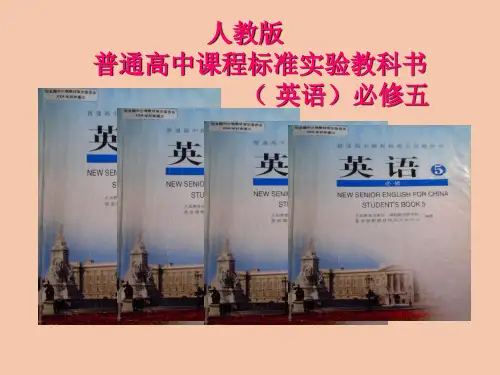
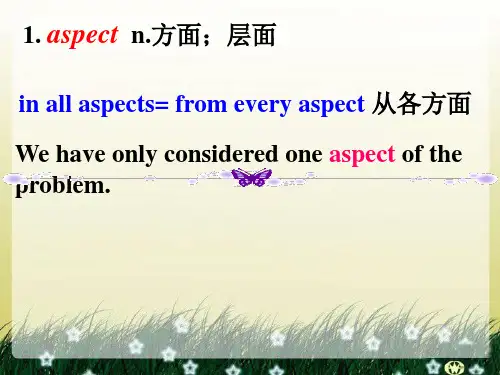
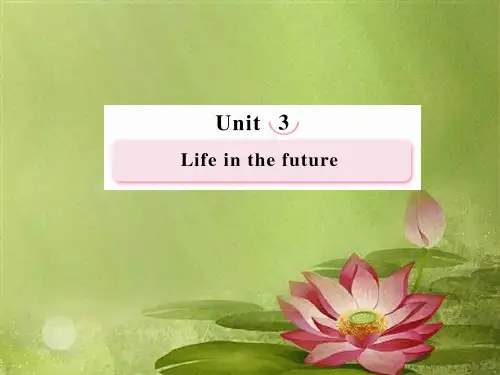
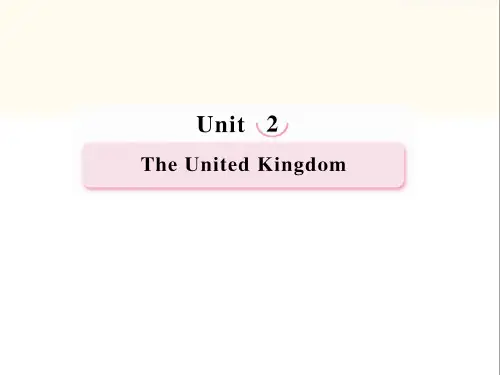
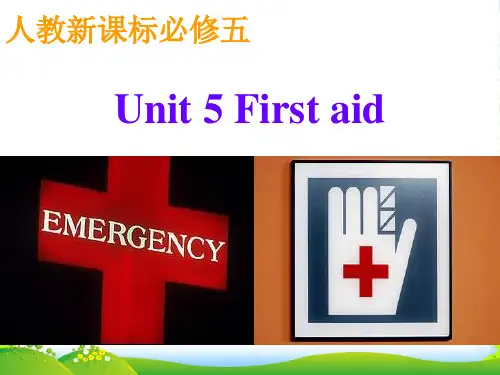

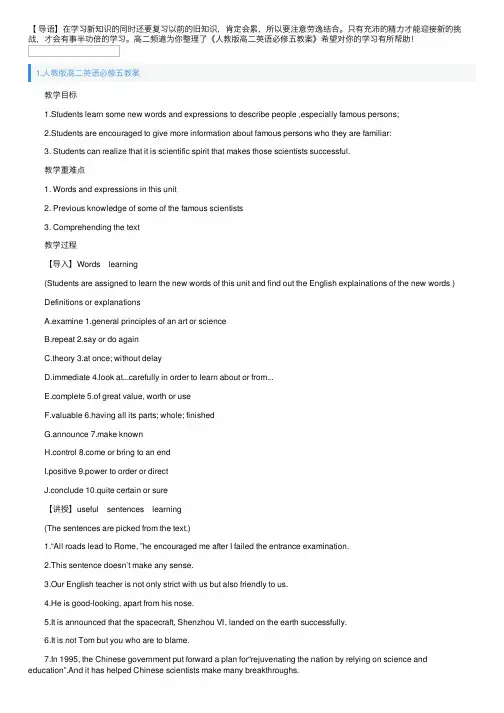
【导语】在学习新知识的同时还要复习以前的旧知识,肯定会累,所以要注意劳逸结合。
只有充沛的精⼒才能迎接新的挑战,才会有事半功倍的学习。
⾼⼆频道为你整理了《⼈教版⾼⼆英语必修五教案》希望对你的学习有所帮助!1.⼈教版⾼⼆英语必修五教案 教学⽬标 1.Students learn some new words and expressions to describe people ,especially famous persons; 2.Students are encouraged to give more information about famous persons who they are familiar: 3. Students can realize that it is scientific spirit that makes those scientists successful. 教学重难点 1. Words and expressions in this unit 2. Previous knowledge of some of the famous scientists 3. Comprehending the text 教学过程 【导⼊】Words learning (Students are assigned to learn the new words of this unit and find out the English explainations of the new words ) Definitions or explanations A.examine 1.general principles of an art or science B.repeat 2.say or do again C.theory 3.at once; without delay D.immediate 4.look at...carefully in order to learn about or from... plete 5.of great value, worth or use F.valuable 6.having all its parts; whole; finished G.announce 7.make known H.control e or bring to an end I.positive 9.power to order or direct J.conclude 10.quite certain or sure 【讲授】useful sentences learning (The sentences are picked from the text.) 1.“All roads lead to Rome, ”he encouraged me after I failed the entrance examination. 2.This sentence doesn’t make any sense. 3.Our English teacher is not only strict with us but also friendly to us. 4.He is good-looking, apart from his nose. 5.It is announced that the spacecraft, Shenzhou Ⅵ, landed on the earth successfully. 6.It is not Tom but you who are to blame. 7.In 1995, the Chinese government put forward a plan for“rejuvenating the nation by relying on science and education”.And it has helped Chinese scientists make many breakthroughs. 8.Have you drawn any conclusion after you read this passage? 9.Well done.So much for the learning of the new words and expressions. 【讲授】Introduction of a classic article Teacher introduce a famous person --Qian Xuesen and students learn to write an article about the famous scientis using the words and expressions they just learn in class. 【活动】Share the outcome Students share their article orally and discuss whether they have used some good and advanced expressions.2.⼈教版⾼⼆英语必修五教案 本教学设计在新课程教学理念的指导下,⼒求在培养学⽣的语⾔知识、知识技能、情感态度、学习策略和⽂化意识等素养的基础上发展学⽣综合运⽤语⾔的能⼒,使学⽣通过观察、体验、探究等主动学习的⽅法优化英语学习⽅法,充分发挥⾃⼰的学习潜能,形成有效的学习策略。
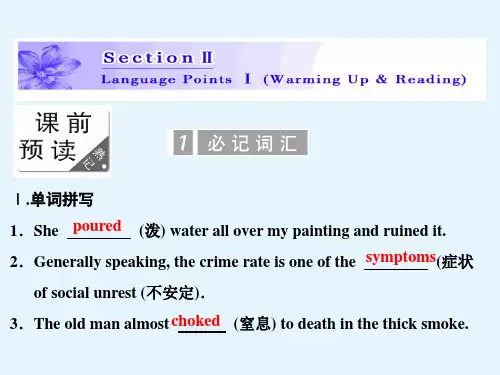
必修五U1 Great Scientist 重点词汇、短语&句型形象记忆[动]construct建造↔[动]destroy破坏[名]construction建造↔[名]destruction破坏形象记忆Many people contributed money to the poor boy, which contributed to his returning to school. A writer wrote a story about this and contributed it to a newspaper.许多人给那个可怜的男孩捐款,使他可以重返校园。
一位作家写了一则关于此事的故事并把它投到一家报社。
形象记忆5. He placed a fixed sun at the centre of the solar system with_the_planets_going_round_it and only the moon still going round the earth.他把固定的太阳放在太阳系的中心,别的行星都围绕太阳转动,只有月亮仍然围绕地球转动。
with the planets going round it 是“with +宾语+宾语补足语”结构,在句中作状语,表示原因、条件、伴随等。
此外,此结构还可作后置定语。
with 复合结构的构成:with +宾语+⎩⎪⎨⎪⎧ adj ./adv ./介词短语宾语和宾补之间是主动关系宾语和宾补之间是被动关系不定式作宾补有“将来”的含义①The little boy ran along the street with nothing on. 这个小男孩沿街跑着,什么也没穿。
②With prices going_up,_we can't afford too many clothes. 随着物价的上涨,我们买不起太多的衣服。
人教版高中英语必修五知识点详解Units 1-21.doubtdoubt是高考中旳高频考察词汇。
doubt可作动词和名词, 是新课标重点词汇。
其命题角度为: ①作动词时, 若为肯定句, 后跟宾语从句,一般用if/whether引导, 若为否认句, 则一般用that 引导。
②doubt作名词时, 一般用于There is no doubt that ...(毫无疑问)构造。
高考对doubt旳考察还将集中在其后跟从句时连接词旳选择上, 也有也许将doubt与其他动词或名词放在一起进行词义辨析。
2.exposeexpose是新课标规定掌握旳单词, 应重点掌握它旳义项及常见使用方法, 尤其是be exposed to 句式, 其中to为介词, 后跟名词、代词和动名词;同步注意exposed to作后置定语和用于句首作状语旳使用方法。
此外, being exposed to构造用动名词形式作主语也是重点和难点, 极易考察。
预测命题方向为exposed to 作状语和定语旳使用方法。
3.absorbabsorb是新课标重点单词, 重点掌握其“吸取(液体, 热);吸取, 理解(知识)”旳词义及其be absorbed in(全神贯注于……)旳使用方法, 易考点为该短语位于句首作状语和作后置定语两点, 考生应能掌握be absorbed by(为某事物所吸引);还应联络be engaged in, be devoted to, be involved in和be lost in等常见重点近义短语。
4.apart fromapart from是常见介词短语, 意为“除……之外”, 考生应纯熟掌握近义旳词和短语: except, besides, in addition (to), other than, except for, except that, except when等。
预测高考会在单项填空题中直接考察或者会出目前阅读理解题中。
教学设计《普通高中课程标准实验教科书英语》必修5 Unit5 First Aid-First Aid for Burns所教年级高二年级单元Unit5 First Aid-First Aid for Burns本节课以First Aid for Burns为话题,结合学生日常生活中经常发生的小意外以及处理方法,设计了warming up部分;Reading部分主要围绕First Aid for Burns主要设计主题了解如何处理不同程度的烧伤。
1.整体设计思路本单元出自是人民教育出版社出版的高二英语新教材必修5的第五单元First Aid-First Aid fo rBurns,其中心话题围绕“First Aid”展开,reading部分是本课的重点,重在训练学生精确找到阅读信息的能力,并且从阅读中获取解决实际问题的技能,如怎样判断烧伤的不同等级以及如何处理烧伤。
本课所学到的知识有利于学生解决生活中的实际问题。
Warming-up 以学生实际生活中可能遇到的小意外的照片引入话题,激发学生兴趣;阅读部分以阅读任务推动,引导学生发展阅读能力;读后部分以小组为单位学习不同小意外的处理方法,然后进行班级分享,鼓励学生以动作、语言输出所学知识,并结合实际情况学以致用。
总结部分采用新闻视频,让学生观看一名护士利用急救知识偶然在高速公路上久了一名发生车祸的陌生人的新闻报道,引导学生形成用所学拯救他人的价值观,弘扬社会主义核心价值观。
2.教学背景分析本课的授课对象是高二的学生,已经积累了一定的英语阅读技巧,但学生不习惯用英语表达。
学生情况分析:本单元所涉及的话题对于学生来说并不陌生,但是学生平时很少关注具体情况下的急救办法,希望教材分析:通过本课的学习,教会学生如何应对可能出现的生活小意外,并提高急救意识。
3.教学目标分析1.Get familiar with some useful words , phrases and sentence patterns in this passage. Teaching aims:2. Improve the reading skills3.Know some simple skills of first aid and use what we have learned to help othersaching important and difficult points:Get students to acquire some first aid skills through readingHow to output what they learnt into practice to solve some daily problems.5.教学过程设计Teaching procedures:tep2.Lead-in(Teacher should take some photos about daily accidents of students before lass.) Look at the pictures. What happened to the students? What should we do to helphem? (Draw students' attention to the topic "First Aid")2. Task1:What is first aid?A form of help given to someone who suddenly fall ill.There are other times when giving first aid quickly can save people's lives.Step3. Reading1.Fast reading:Task2:Scan for the structure of the passagePart 1:The Introduction of the skinpart 2: the characteristics of burnsPart 3: the treatment of burns2.Detailed reading:1.:What may cause burns?2: What is the feature of second degree burns?3: Why is it necessary to remove the burns?Step 4: Summarize and homework。
人教版高二英语必修五unit5教案例文整理老师要上好一节课,往往需花费十倍于它的或更多的时间作预备。
仔细写好教案是合格老师的基本功。
那么应当怎么写好教案呢?今日我在这里给大家共享一些有关于人教版高二英语必修五unit5教案最新例文,盼望可以关心到大家。
人教版高二英语必修五unit5教案最新例文4一.学情分析从同学高一理科期末考试状况来看,存在以下三方面问题:①在思想上、态度上放松或放弃的现象有所表露,读,不会读,就谈不上听得懂,看得懂,从而导致破罐子破摔的现象。
①基础学问不够扎实,敏捷运用语言的技能相对薄弱。
①运用力量不够强实。
同学的阅读力量、理解力量、分析力量、推断力量、应变力量等均不能较好地适应考查要求。
二.解决方法和详细工作1、仔细落实集体备课。
以集体备课为形式,集备课组全体的才智做好日常的教学工作。
详细做法如下:1、集体研讨,统一教学进度,教学目标,确定重点和难点;2、分工合作,收集备课资料,做到精选精练,突出应用与力量; 3》.整合教材,敏捷使用,变成实效性教材;4、摒弃不切实际的教学步骤,抓重点,搞强化,在日常教学中渗透语法意识。
2、利用教材提高同学的基本功,坚持默写单词及重点句型,培育同学的阅读力量,并以此材料为基础,扩充同学词汇量扩展同学阅读量,努力补充同学的词汇。
3、听力强化我们准备选用听力材料,作为日常听力训练。
4、综合检查1》预备每一单元做一次练习,主要以结合当前教学内容为主要测试内容,间或分块测试,习题的训练在于精而不在于多。
选择典型性题目,针对共性问题进行精讲。
2》在平常教学过程中不断扩高校生的词汇量,词汇教学以新带旧,从而达到巩固扩充词汇的目的,做到常常督促、检测。
总之,高二理科的教育教学工作任务虽然比较重,但是备课组的全体老师坚信只要我们团结全都,互研合作,虚心仔细,辛勤耕耘,追求科学方法,求真务实,优化教材资源,夯实“双基”,创新课堂教学模式,培育英语力量,我们的明天会更好!人教版高二英语必修五unit5教案最新例文5一、指导思想:在进一步明确了教学中应坚持的三个坚决即:以同学为主体,老师为主体,思维训联为主线。
人教版高中英语必修5篇一:高中英语必修5课文逐句翻译(人教版)1.必修五Unit 1 JOHN SNOW DEFEATS “KING CHOLERA”约翰·斯诺击败“霍乱王”John Snow was a famous doctor in London - so expert, indeed, that he attended Queen Victoria as her personal physician.约翰·斯诺是伦敦一位著名的医生——他的确医术精湛,因而成为照料维多利亚女王的私人医生。
But he became inspired when he thought about helping ordinary people exposed to cholera.但他一想到要帮助那些得了霍乱的普通百姓时,他就感到很振奋。
This was the deadly disease of its day.霍乱在当时是最致命的疾病,Neither its cause nor its cure was understood.人们既不知道它的病源,也不了解它的治疗方法。
So many thousands of terrified people died every time there was an outbreak.每次霍乱暴发时,就有大批惊恐的老百姓死去。
John Snow wanted to face the challenge and solve this problem.约翰·斯诺想面对这个挑战,解决这个问题。
He knew that cholera would never be controlled until its cause was found.他知道,在找到病源之前,霍乱疫情是无法控制的。
He became interested in two theories that possibly explained how cholera killed people.斯诺对霍乱致人死地的两种推测都很感兴趣。